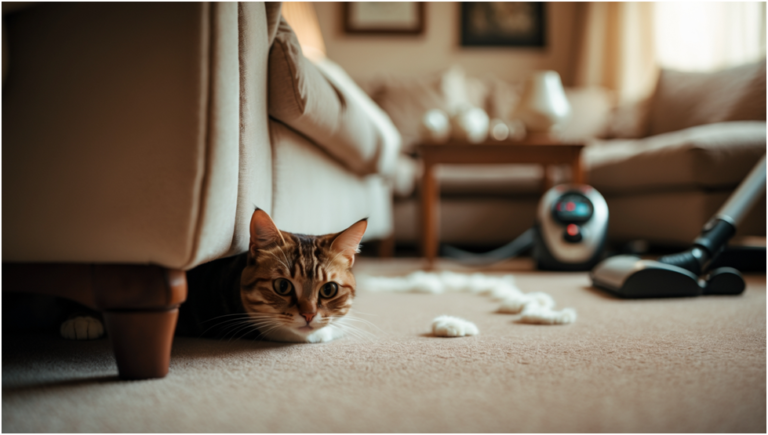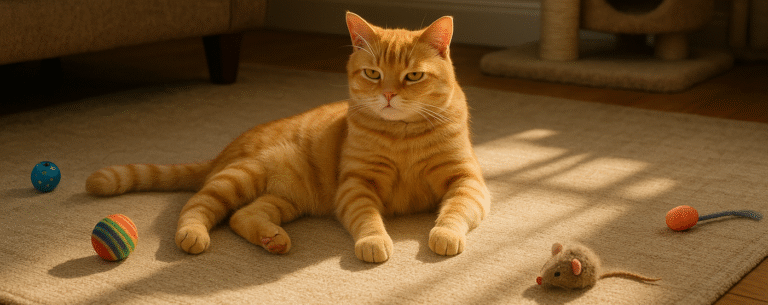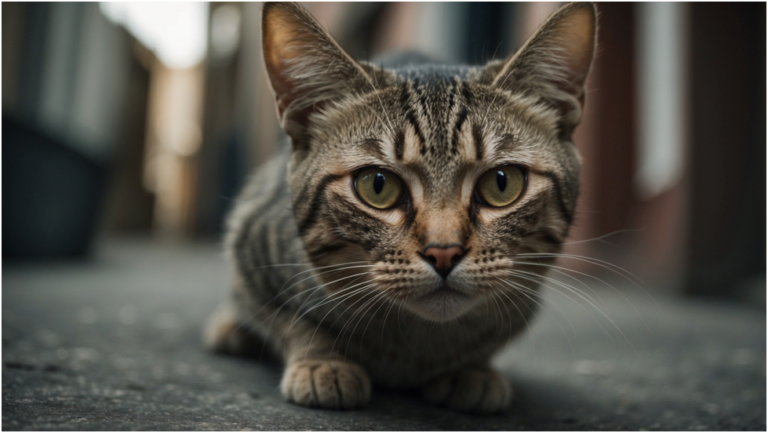Comprehensive Guide to Recognizing and Caring for Sick Cat Behavior
I have cared for cats as an owner for 5 years, alongside my love for all animals. Over these years, I found that cats naturally disguise their sickness signs. Their instinct is to keep hidden from predators by concealing their weak spots. A study published in the Journal of Feline Medicine states that painful cats hide their suffering intensely. Based on my expertise and research results, this guide will show you how to find illness problems in your cat before they become severe.
Identifying the Initial Health Issues in Cats
Identifying sickness at its beginning stages protects your feline companion. Researchers from Cornell University found that beginning medical treatment before symptoms progress will help recover 80% of feline patients. By observing changes in my cats early I was able to get them medical attention that saved their lives.
Physical Indicators of a Sick Cat
The way your cat looks always gives you vital information about their health condition. Learn how your cat feels healthy so you will quickly notice when something appears different.
Changes in Appearance
Observe any weight fluctuations in your cat’s body. According to vets, “immediate medical help is needed when a cat loses 10% of its weight.”
My tabby cat, Whiskers, demonstrated this lesson to me. He kept eating at the usual rate, yet his weight dropped quickly. A vet visit revealed hyperthyroidism.
Dr. Elizabeth Colleran, former president of the American Association of Feline Practitioners suggest that Weight loss in senior cats demands immediate attention. Significant weight loss often shows as the first and sometimes the only symptom of illness in your cat.
Check your cat’s coat. The coat of a healthy cat should remain sleek and vibrant. My cats reduce their grooming when unhealthy, and their coats appear unkempt. Deteriorating coat quality, excessive hair loss, or dandruff may indicate health problems.
Grooming Habits
Healthy cat spend 30 to 40% of its alert time in grooming activities. Changes in this routine often indicate that your kitty is facing a serious problem.
Over-grooming vs. Under-grooming Signs:
| Behavior | Possible Indicators | When to Worry |
| Over-grooming | – Bald patches – Skin irritation – Excessive licking of specific areas | – When behavior lasts more than a few days – If causing skin damage – When combined with other symptoms |
| Under-grooming | – Oily coat – Matted fur – Dandruff or skin flakes | – Sudden change in a clean cat – When combined with lethargy – If lasting more than 24-48 hours |
| Normal grooming | – Routine cleaning several times daily – Even attention to all body parts | – N/A – This is healthy behavior |
My work with different cats shows that overgrooming points to allergic reactions, distress, or discomfort. When a cat does not groom itself correctly, it indicates low energy levels and discomfort in the mouth or with movement.
Body Posture and Movement
My black cat Shadow began moving with a bent back while keeping his body close to the floor. His unusual posture made me bring him to the vet immediately. The medical scan revealed pancreatitis inside his body. How your cat stands, sits and moves offers clues about their condition.
Healthy cats use their whole body structure to move smoothly and stand evenly on all paws. According to the Journal of Veterinary Behavior research, 78% of cats with altered walking positions had a medical issue. Watch for:
- Limping or favoring one leg
- Avoiding jumping or climbing
- Stiffness when getting up
- Walking oddly or stumbling
- Hunched or crouched position (often indicates pain)
Behavioral Changes in Sick Cats
Cats display changes in behavior well before showing physical indicators of illness.
Changes in Activity Levels
A loss of normal energy and willingness to perform usual activities hints at health problems. My ordinarily active 3-year-old Bella began to sleep more than usual. Despite seeming trivial, it triggered us to take Bella to the vet. The blood tests detected minor kidney disease symptoms that enabled us to modify the diet before lasting harm happened.
There are distinct activity indicators that show when a cat becomes sick.
• More sleeping than usual
• Less interest in play
• Less interaction with family
• Inappropriate energetic movements (point toward pain or hyperthyroidism problems)
According to feline expert Dr. Gary Norsworthy, “changes in activity behavior usually appear first when a cat feels unwell. People tend to overlook when their pets sleep more because they assume aging has caused it, but it often means that your purr companion is in pain and needs your attention. “
Social Interaction Shifts
Throughout the years, I have noticed that cats display different social habits when they become sick. When sick, my usually playful cats stop socializing with me and prefer to stay in their space. My solitary cats made an abrupt demand for interaction.
According to The Ohio State University research “67% of cats who suffer from undetected pain reduce their social engagement. ” Look for these telling changes:
• Hiding in unusual places
• Avoiding family members
• Unusual aggression when touched
• Unusual clinginess or neediness

Sick cat in a hallway with concerned family in the background.
Litter Box Behavior Changes
Litter box use patterns provide clear insights into how well your cat feels. My cat Mittens began using the litter box often while producing very little pee. A vet visit found that Mittens suffered from urinary tract inflammation, which required medical attention.
Common Litter Box Warning Signs:
| Behavior | Possible Health Concerns | Emergency Level |
| Frequent box visits with little/no urine | Urinary blockage, cystitis, UTI | EMERGENCY – especially for male cats |
| Straining to urinate | Crystals, stones, infection | EMERGENCY |
| Blood in urine | Infection, inflammation, stones | Urgent |
| Urinating outside box | UTI, bladder inflammation, stress | Warrants vet visit |
| Excessive urination | Diabetes, kidney disease, hyperthyroidism | Requires vet check |
| Crying when using box | Pain from various causes | Warrants prompt vet visit |
According to the American Animal Hospital Association, “medical conditions lead to 60% of litter box issues in cats. “
Understanding Cat Body Language
Cats show their feelings primarily by small body signals which most cat owners overlook.
Tail and Ear Positioning
Cat reveals much about their health and feelings by how they hold their ears and tail.
Tail Movements and What They Mean
Your cat shows their emotional and health status through tail position and movements. By closely examining my research, I have discovered the specific meaning of each tail position.
• When a cat holds its tail close to its body, it shows fear, anxiety, or pain.
• Puffed tail signals fear or aggression, sometimes pain .
• The tail tip wiggles when the cat feels minor unrest or enthusiasm.
• Rapid thrashing: Pain, high irritation, or overstimulation
Ear Orientation and Its Significance
Emotions and physical experiences cause quick changes in ear position. A cat’s ears naturally point toward the front when it feels well or moves to track sounds. During illness
• Flat ears show your cat feels pain, fear, or defend itself.
• One ear moves downward, which suggests a possible ear infection.
• Ear scratching and head shaking occur frequently because of ear mites or infectious agents within the ear.
• The cat exhibits minor signs of nervousness by holding its ears back but not flat
Eye Expressions and Posture
A cat’s eyesight and body orientation help owners recognize their health status.
Eye Expressions and Pupil Response
Throughout my time owning cats, I have mastered examining their pupil reactions, as they help me determine how their nervous system works and how they feel. Well, cats display equal pupils, which grow smaller in bright light and bigger in dim light.
According to veterinary pain specialist Dr. Sarah Brandon, “The eyes truly are windows to a cat’s health. Pupil size, eye position, and third eyelid visibility can all indicate pain or illness before other symptoms appear.”
Notice these signs that show eye problems:
• When pupils stay wide open, it shows that the cat suffers from pain, fear, or neurological conditions.
• Small pupils in regular lighting often signal eye inflammation.
• When your cat partially closes its eyes or squints, it shows signs of painful eye problems.
• Discharge or excessive tearing: Infection or irritation
• Cloudiness or visible third eyelid: Several medical concerns
Overall Posture and Health Indicators
Through my observations of sick cats, I have noticed that they naturally position their bodies to ease their suffering. A healthy cat stands straight while placing equal pressure on every leg.
According to research in The Veterinary Journal, ” 93% of cats with diagnosed pain conditions displayed evident changes in their posture that owners could notice. ” A cat shows pain or sickness by displaying these traits.
• Hunched posture with arched back
• Position their weight on a single side while sitting
• keep their limbs closed under their body while resting.
• Head held low or tilted
• Struggles to find a resting position and adjusts frequently.
Common Causes of Cat Sickness
Understanding potential cat illnesses enables you to take protective steps and deal with issues effectively when they arise.
Dietary Issues
What your cat eats directly determines their wellness.
Food Sensitivities and Allergies
I discovered more food sensitivities in house cats by observing my feline friends and exchanging information with other pet owners. An actual food allergy causes immune system reactions, but a food intolerance leads to an upset stomach without immune system involvement.
Experts in Veterinary Dermatology saw that 10 to 15 % of feline skin diseases result from dietary sensitivities.
My cat Jasper had constant ear infections that ended when I removed the chicken from his food. This proof demonstrates how food reactions can show up in unexpected ways.
Signs of Food Sensitivity in Cats:
| System Affected | Common Symptoms | Foods Often Implicated |
| Skin | – Itching, especially around head/neck – Excessive grooming – Skin lesions | – Beef – Dairy – Fish |
| Digestive | – Vomiting – Diarrhea – Gas | – Dairy – Grain fillers – Artificial additives |
| Respiratory | – Coughing – Wheezing – Nasal discharge | – Less common with food sensitivity |
Dietary Indiscretions
When cats eat non-food items, it can cause serious health issues, and their stomach becomes unhealthy. While working with cats, I have treated several pets for these problems.
• Plants (some toxic to cats)
• String or ribbon
• Spoiled food
• Too many hairballs from grooming
Infections and Illnesses
Infections become the primary reason behind sick cats by targeting different parts of their bodies.
Upper Respiratory Infections (URI)
Multiple cats in one household increase the speed at which upper respiratory infections spread between them. Through my shelter volunteer work I have treated many cats with Upper Respiratory Infection symptoms such as :
• Sneezing and runny nose
• Coughing
• Eye discharge
• Fever
• Lethargy
• Reduced appetite
Dr. Kate Hurley from UC Davis Koret Shelter Medicine Program explains that URIs work like seasonal flu in humans. They spread quickly, yet most cases can be handled through appropriate treatment. URIs may create life-threatening dangers for young kittens, elderly felines, or immune-compromised felines.
A Cornell Feline Health Center study shows that cats are exposed to feline herpesvirus or calicivirus for at least 90% of their lifetime. These viruses create most of the health problems associated with URIs.
Gastrointestinal Infections
Infections of the digestive system create pain for cats and put them at risk of dehydration. Signs to watch for include:
• vomiting , especially when blood or frequent events happen.
• Diarrhea
• Belly pain (hunched posture)
• Reduced appetite
• Lethargy
Urinary Tract Infections (UTIs)
After researching urinary health, when my male cat developed crystals, I emphasized prompt action for urinary problems. Male cats need immediate medical help because their condition could be fatal. Watch for:
• Many visits to the litter box with little pee
• Straining to urinate
• Blood in urine
• Crying while urinating
• Urinating outside the litter box
The American Veterinary Medical Association reports that urinary tract disease affects 1-3% of cats who visit veterinary clinics. The risk of urethral blockage for male cats is 5 to 10 times higher than for female cats.
Parasites and Infestations
Parasites present a regular health danger to cats that stay indoors.
Fleas, Ticks, and Mites
Parasites on the body make cats itch, cause skin problems, and can cause diseases. My indoor cat picked up fleas from my clothes when I visited a friend with a pet infected with fleas. Even Indoor cats need parasite protection.
Signs of external parasites include:
• Excessive scratching
• Visible parasites in fur
• Hair loss
• Skin irritation or scabs
• Black flea dirt during fur combing.

Cat owner removing a tick from their cat’s fur
Internal Parasites
Various intestinal parasites such as roundworms, tapeworms, and hookworms infect cats across different age groups. The Companion Animal Parasite Council reports that 45% of cats carry gastrointestinal parasites when appropriately tested. Signs include:
• Visible worm segments in the stool or around the anus
• Pot-bellied appearance (especially in kittens)
• Diarrhea or vomiting
• Weight loss despite good appetite
• Dull coat
Systemic Diseases
Various health disorders in multiple body organs demand permanent treatment throughout life.
Kidney Disease
By caring for senior cats and reading vet resources, I discovered that kidney disease impacts about 30% of elderly cats. Early detection dramatically improves outcomes. Watch for:
• Increased thirst and urination
• Weight loss
• Poor appetite
• Vomiting
• Bad breath (ammonia smell)
Dr. Jessica Quimby, a specialist at Ohio State University, emphasizes that early diagnosis of kidney disease gives us more ways to control its progression and keep cats active. Increased senior cat thirst requires a medical examination.
Hyperthyroidism
This common hormone disorder in older cats causes:
• Weight loss despite increased appetite
• Hyperactivity
• Vomiting
• Excessive thirst and urination
• Poor coat condition
• Heart abnormalities
Diabetes Mellitus
Cat diabetes usually presents these symptoms:
• Excessive thirst and urination
• Weight loss despite good or increased appetite
• Lethargy
• Weakness, especially in the rear legs
• More frequent infections
According to Banfield Pet Hospital, the number of cats diagnosed with diabetes grew 18% from 2011 to 2018 because of an increase in overweight cats.
How to Help a Sick Cat
From my work as a cat owner and rescue volunteer, I have learned that emergency response determines whether an animal survives.
Identifying When Your Cat Needs Professional Medical Attention
Early vet contact determines whether your cat needs simple treatment or urgent medical care.
Severe Symptoms Requiring Immediate Attention
Some conditions are true emergencies. Using vet insight and my knowledge these conditions must have urgent medical attention.
• Difficulty breathing
• Unable to urinate (mainly male cats)
• Severe lethargy or unresponsiveness
• Seizures
• Trauma (falls, attacks, etc.)
• Eating toxic substances
• Heavy vomiting or diarrhea
• Severe pain
• Collapsed/unable to stand
According to the Veterinary Emergency and Critical Care Society study, ” patients suffering from urinary blockage and receiving late treatment are at risk of dying more than 50% of the time. Immediate medical attention creates better treatment results. “
Comfort Measures at Home
A cat’s recovery depends on good home care between veterinary appointments.
Setting Up a Peaceful Recovery Space
Recovery spaces should be:
• Quiet and calm
• Kept at a comfortable temperature
• The space must stay undisturbed by other domestic animals.
My cat Tiger needed less time for recovery after surgery because I moved him to a quiet bedroom separate from family activities and other animals.

Cat owner feeding a sick cat in a cozy bedroom.
Ensuring Proper Nutrition and Hydration
It is essential to help your sick cat eat during illness. Techniques I’ve successfully used include:
• Warming canned food to enhance its smell
• Hand-feeding small amounts often
• Using special appetite stimulant foods
• Mixing water in food for hydration
• Pet fountain helps cats stay hydrated by encouraging them to drink more water.
Dr. Debra Zoran advises that cats need proper nutrition at regular intervals to avoid developing fatty liver disease. Illness treatment requires equal attention to medicine and adequate calorie consumption. Treatment Options for Sick Cats
Understanding how to treat sick cats properly lets you support your vet’s medical plan.
Medications and Their Use
The correct administration of medicines leads to better disease control. Based on my work with cats that have ongoing health problems, I suggest the following:
• Put tablets into pill pockets or maskers when giving medication to cats.
• Request the medicine in liquid form when possible.
• Learning gentle restraint techniques
• Following dosing schedules exactly
• Watching for side effects
At-Home Supportive Care
Supportive care enhances medical treatment. Effective approaches include:
• Tracking food/water intake
• Helping with grooming when needed
• Providing easily accessible litter boxes
• Keeping follow-up appointments
• Note how symptoms change when using medication.
Preventing Future Illnesses and Maintaining Health
Regular medical check-ups help cats stay healthy longer than any other form of treatment.
Routine Health Care and Preventive Measures
Standard cat health care stops many regular illnesses from appearing.
Regular Veterinary Check-Ups
My dedication as a cat owner shows that wellness check-ups stop health problems from becoming severe. According to the American Animal Hospital Association, “cats under routine preventive care plans live two to three years longer than cats without such care.” Recommended schedule:
• Young kittens need their first vaccine doses and parasite protection for good health.
• Adults (1-7 years): Annual check-ups
• Older cats above 8 years need blood tests during annual check-ups.
Preventive care should include:
• Essential vaccines according to lifestyle threats.
• Parasite prevention
• Dental assessments
• Weight management
• Behavior evaluations
Conclusion
According to my experience with many cats and cat owners, observing your cat closely and responding promptly to changes helps maintain its good health. When you recognize your cat’s slight behavioral signals, you obtain significant early signs of their distress. By observing how your cat behaves under normal conditions you can easily spot when they show clear signs of illness.
Use your understanding of your cat to take action when you sense something is wrong. When pet parents and veterinary staff work together, our cats get professional help during challenging times.
Faqs
- How can I tell if my cat is dehydrated, and what should I do?
Look for sunken eyes, dry gums, or skin that stays tented when pinched. Offer fresh water, use a pet fountain, or give wet food. If symptoms persist, see a vet for fluids. Regular water access is crucial, especially for cats with kidney or diabetes issues - What are the signs of dental disease in cats, and how can I prevent it?
Bad breath, drooling, or red gums may signal dental disease. Brush your cat’s teeth with pet-safe toothpaste, provide dental treats, and get yearly vet check-ups. Untreated issues can lead to infections affecting the heart or kidneys, so regular care is essential. - Why is my cat vomiting frequently, and when should I be concerned?
Frequent vomiting, blood in vomit, or lethargy are concerning. Causes include hairballs, diet issues, or blockages. If vomiting occurs daily or with other symptoms, visit a vet for tests or diet changes to address the problem quickly. - How do I know if my cat is in pain, and what can I do to help?
Signs include hiding, reduced appetite, or aggression when touched. Create a calm space with easy access to food and litter. Use only vet-prescribed pain relief—human medications are toxic. A vet can diagnose and treat the cause for your cat’s comfort - What should I do if my cat stops eating, and how long is too long?
If your cat stops eating for over 24 hours, it’s serious, risking liver issues. Try warming food or offering treats. If they don’t eat within a day, see a vet to check for illness, stress, or dental problems. Quick action prevents complications. - Can stress cause illness in cats, and how can I reduce it?
Stress can lead to urinary issues or over-grooming. Watch for hiding or inappropriate urination. Maintain consistent routines, offer toys, and use pheromone diffusers. Gradual changes, like introducing new pets, help. A stress-free environment supports your cat’s health. - How can I safely transport a sick cat to the vet?
Use a sturdy carrier with soft bedding and familiarize your cat with it beforehand. Secure the carrier during travel, cover it to reduce stress, and bring symptom notes. For emergencies, call the vet en route to ensure prompt care.







